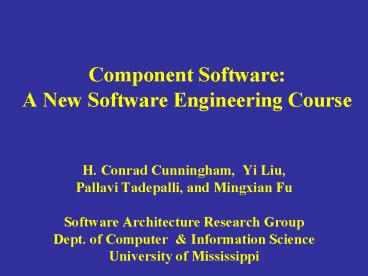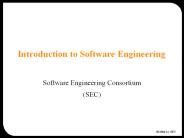Component Software: A New Software Engineering Course - PowerPoint PPT Presentation
Title:
Component Software: A New Software Engineering Course
Description:
'Acxiom Laboratory for Software Architecture and Component ... persistent state (associated database). System Services. Operations are new transactions. ... – PowerPoint PPT presentation
Number of Views:47
Avg rating:3.0/5.0
Title: Component Software: A New Software Engineering Course
1
Component SoftwareA New Software Engineering
Course
- H. Conrad Cunningham, Yi Liu,
- Pallavi Tadepalli, and Mingxian Fu
- Software Architecture Research Group
- Dept. of Computer Information Science
- University of Mississippi
2
Acknowledgements
- Acxiom Corporation grant
- Acxiom Laboratory for Software Architecture and
Component Engineering (ALSACE) - University of Mississippi
- School of Engineering
- Department of Computer and Information Science
3
Why Components?
- Contemporary context of enterprise software
- large, complex distributed systems
- shared use of preexisting software and data
assets - changing requirements
- short development schedules
- incremental and decentralized development
- economic pressures to increase productivity
- Creates needs
- strong encapsulation (information hiding)
- easy reuse, composition, and replacement of
modules - persistence, transactions, security, etc.
4
What is a Component?
- Clemens Szyperski
- A software component is a unit of composition
with a contractually specified interface and
explicit context dependencies only. A software
component can be deployed independently and is
subject to composition by third parties.
5
Software Components
required interfaces
required interfaces
provided interfaces
provided interfaces
interfaces
Component implementation
Component1
Component2
6
Course Principles
- Separation of concerns
- product from the process
- logic into architectural layers
- Use and adaptation of standard notations and
methods - build on object-oriented analysis and design
techniques - construct system of components
- use Unified Modeling Language (UML)
- Development of software families
7
Layered Architecture
8
Development Workflow
Business requirements
Requirements
Use case models
Domain models
Technical constrains
Components
Use case models
Specification
Provisioning
Assembly
Component specs architectures
Applications
Test
Tested applications
Deployment
9
Course Structure
- Component concepts and requirements definition
- 4 weeks
- Component specification
- 4 weeks
- Component implementation
- 5 weeks
10
Part 1 Concepts and Requirements
- Component concepts
- Domain modeling
- grammatical analysis, etc.
- domain concept model (UML class diagrams)
- Use case modeling
- analysis of business processes
- examination of create/delete/update of entities
- documentation of success and failure scenarios
11
Domain Model
12
Use Case Model
13
Scenarios
- Name Make Schedule
- Initiator Student
- Goal Make a valid course schedule
- Success Scenarios
- Student logs in
- Student asks to make schedule for some term
- Student adds/deletes sections
- Student submits schedule
- System checks schedule validity
- System notifies Billing systen
- Extensions
- 1. Login failure
- (a) repeat login
- 1a. Repeated login failure
- (a) access denied
- 5. Invalid schedule submitted
- (a) system notifies student
- (b) repeat beginning at step 3
14
Part 2 Component Specification
- Design methods
- Identification of components (core type analysis)
- Discovery of operations (interaction modeling)
- Refinement of specification and architecture
details - Approach
- Emphasize systematic methods independent from
specific component technologies - Support mapping of designs to different
technologies
15
Specification Phase
16
Interface Responsibility
17
Initial Component Architecture
18
Part 3 Component Implementation
- Concepts of the target technology
- Enterprise JavaBeans (EJB)
- Mapping specifications to target technology
- Design and implementation of component internals
- Assembly, testing, and deployment issues
19
J2EE Architecture
20
Architecture Mapping to EJB
21
Textbooks
- J. Cheesman and J. Daniels. UML Components A
Simple Process for Specifying Component-Based
Software, Addison Wesley, 2001. - H. M. Deitel, P. J. Deitel, and S. E. Santry.
Advanced Java 2 Platform How to Program,
Prentice-Hall, 2002. - G.T. Heineman and W.T. Councill. Component-Based
Software Engineering Putting the Pieces
Together, Addison Wesley, 2001. - D. Rosenberg and K. Scott. Use Case Driven Object
Modeling with UML A Practical Approach, Addison
Wesley, 1999.
22
Instructor Experiences
- 25 graduate students in Fall 2002
- Parts 1 and 2 satisfactory, but needs
- better integration
- complete and timely feedback on student projects
- attention to design by contract methods
- Part 3 unsatisfactory and needs
- earlier coverage of and more practice with EJBs
- expanded attention to mapping of specifications
to EJBs - stable software environment for student projects
- coverage of user interface technology (e.g., JSP)































